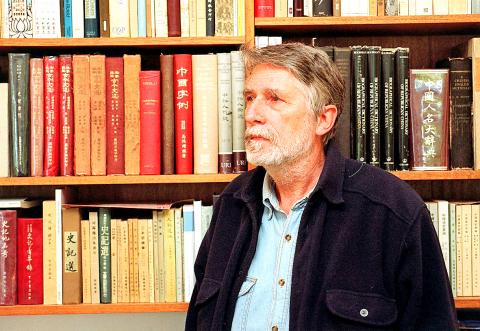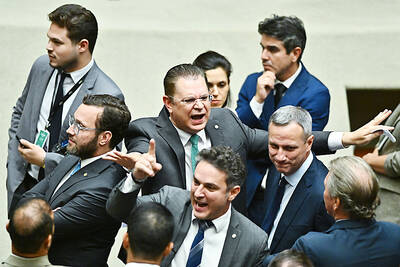Pierre Ryckmans, a Belgian-born scholar of China who challenged a romanticized Western view of former Chinese leader Mao Zedong (毛澤東) in the 1960s with his early portrayal of Mao’s Cultural Revolution as chaotic and destructive, died on Monday last week at his home in Sydney, Australia. He was 78.
His daughter, Jeanne Ryckmans, said the cause was cancer.
Ryckmans, who was better known by his pen name, Simon Leys, fell in love with China at the age of 19 while touring the country with fellow Belgian students in 1955.

Photo: AFP
One highlight was an audience with then-Chinese prime minister Zhou Enlai (周恩來). The man-made famine of Mao’s Great Leap Forward and his Cultural Revolution, which began in 1966 and ended about the time of Mao’s death, in 1976, were still in the future. There was much to be admired in the new China.
Yet pursuing his studies of Chinese art, culture and literature in the People’s Republic of China itself was not an option for a Westerner, so he settled in Taiwan, where he met his future wife, Chang Han-fang. He also lived in Singapore and Hong Kong.
It was in Hong Kong during the late 1960s that Ryckmans began to follow the turmoil just across the frontier, reading accounts in the official Chinese press about the Cultural Revolution and talking to former Mao supporters who had escaped it.
He began to find that the romantic view of Mao harbored by many Western intellectuals — as a progressive if flawed champion of the masses — was completely at odds with the cruelties of the Cultural Revolution, which sought to eradicate Chinese cultural traditions and Western capitalist influences and replace it with a Maoist orthodoxy. The movement led to purges, forced internal exiles and whipsaw shifts in the political winds, and it compelled Ryckmans to step into the arena of political commentary.
“Until 1966 Chinese politics did not loom large in my preoccupations, and I confidently extended to the Maoist regime the same sympathy I felt for all things Chinese, without giving it more specific thought,” Ryckmans wrote under his pseudonym in Chinese Shadows, which was first published in French in 1974.
“But the Cultural Revolution, which I observed from beginning to end from the vantage point of Hong Kong, forced me out of this comfortable ignorance,” he wrote.
His first account, The Chairman’s New Clothes, was also published in French, in 1971, a year after he had settled in Australia to teach at Australian National University. Ryckmans wrote the book under the name Simon Leys to disguise his identity so that he would not be banned from China.
He returned to China in 1972 on a six-month assignment as a cultural attache for the Belgian embassy in Beijing. The wanton destruction of the city’s ancient architectural heritage shocked him.
In Chinese Shadows, he wrote of his frantic search for some of the most magnificent of the city’s huge gates, which he assumed had been preserved, even though he knew that the city walls had been taken apart starting in the 1950s. The gates were gone.
“The destruction of the gates of Peking is, properly speaking, a sacrilege; and what makes it dramatic is not that the authorities had them pulled down but that they remain unable to understand why they pulled them down,” he wrote.
The Cultural Revolution, he found, had destroyed the beauty of Chinese culture and civilization without destroying what needed to be exorcised: the tyranny of arbitrary rule.
In a telephone interview, former Australian prime minister Kevin Rudd, a former student of Ryckmans, called him “the first of the Western Sinologists of the ’60s and ’70s to expose the truth of the cultural desecration that occurred during the Cultural Revolution, ripping away the political veneer from it all and exposing it for what it was: an ugly, violent, internal political struggle within the Chinese Communist Party led by Mao.”
Ryckmans was a frequent contributor to The New York Review of Books, Le Monde and other periodicals and the recipient of several literary prizes.

PARLIAMENT CHAOS: Police forcibly removed Brazilian Deputy Glauber Braga after he called the legislation part of a ‘coup offensive’ and occupied the speaker’s chair Brazil’s lower house of Congress early yesterday approved a bill that could slash former Brazilian president Jair Bolsonaro’s prison sentence for plotting a coup, after efforts by a lawmaker to disrupt the proceedings sparked chaos in parliament. Bolsonaro has been serving a 27-year term since last month after his conviction for a scheme to stop Brazilian President Luiz Inacio Lula da Silva from taking office after the 2022 election. Lawmakers had been discussing a bill that would significantly reduce sentences for several crimes, including attempting a coup d’etat — opening up the prospect that Bolsonaro, 70, could have his sentence cut to

China yesterday held a low-key memorial ceremony for the 1937 Nanjing Massacre, with Chinese President Xi Jinping (習近平) not attending, despite a diplomatic crisis between Beijing and Tokyo over Taiwan. Beijing has raged at Tokyo since Japanese Prime Minister Sanae Takaichi last month said that a hypothetical Chinese attack on Taiwan could trigger a military response from Japan. China and Japan have long sparred over their painful history. China consistently reminds its people of the 1937 Nanjing Massacre, in which it says Japanese troops killed 300,000 people in what was then its capital. A post-World War II Allied tribunal put the death toll

‘UNWAVERING ALLIANCE’: The US Department of State said that China’s actions during military drills with Russia were not conducive to regional peace and stability The US on Tuesday criticized China over alleged radar deployments against Japanese military aircraft during a training exercise last week, while Tokyo and Seoul yesterday scrambled jets after Chinese and Russian military aircraft conducted joint patrols near the two countries. The incidents came after Japanese Prime Minister Sanae Takaichi triggered a dispute with Beijing last month with her remarks on how Tokyo might react to a hypothetical Chinese attack on Taiwan. “China’s actions are not conducive to regional peace and stability,” a US Department of State spokesperson said late on Tuesday, referring to the radar incident. “The US-Japan alliance is stronger and more

FALLEN: The nine soldiers who were killed while carrying out combat and engineering tasks in Russia were given the title of Hero of the Democratic People’s Republic of Korea North Korean leader Kim Jong-un attended a welcoming ceremony for an army engineering unit that had returned home after carrying out duties in Russia, North Korean state media KCNA reported on Saturday. In a speech carried by KCNA, Kim praised officers and soldiers of the 528th Regiment of Engineers of the Korean People’s Army (KPA) for “heroic” conduct and “mass heroism” in fulfilling orders issued by the ruling Workers’ Party of Korea during a 120-day overseas deployment. Video footage released by North Korea showed uniformed soldiers disembarking from an aircraft, Kim hugging a soldier seated in a wheelchair, and soldiers and officials